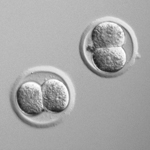To request this service, please fill out and send us the request form.
Sperm cryo-preservation
 Sperm freezing is the fastest and most inexpensive method to cryo-preserve a genetically modified mouse line. However it does not ensure the conservation of homozygosity or recovery of an identical genetic background after thawing the sample and performing in vitro fertilization.
Sperm freezing is the fastest and most inexpensive method to cryo-preserve a genetically modified mouse line. However it does not ensure the conservation of homozygosity or recovery of an identical genetic background after thawing the sample and performing in vitro fertilization.
You would provide us with 3 young (2 to 6 month old) healthy males which have been previously proved to be fertile. We obtain the sperm (the procedure requires the sacrifice of the male) and we freeze down 10 sperm aliquots per male. The frozen specimens are maintained in the liquid nitrogen tanks of the transgenic mouse facility.
This service comprises the assessment of quantity and quality (motility) of the sperm before and after freezing, and the test of the functionality (fertilization rate) of one random frozen/thawed sperm sample per line by in vitro fertilization (IVF). Moreover, we transfer the 2-cell embryos obtained by IVF to recipient females, in order to generate alive pups. Only when we see litters born we would consider the line successfully cryopreserved.
Embryo cryo-preservation
Embryo freezing is the most efficient way to cryo-preserve a mouse line, as it ensures the conservation of an identical genetic background and genotype after an eventual embryo thawing in order to resuscitate the line. It is specially indicated when it is needed to preserve a genetically modified mouse line which carries various mutations in different alleles.
 You would normally provide us with 5 to 10 young (2 to 6 months old) healthy males that have been previously proved to be fertile. We would cross them with super-ovulated females in order to obtain a higher number of embryos. By default, we use C57Bl/6N females, but other genetic backgrounds can be considered upon request. We can also cross your mutant females with wild type males, or set up crosses between males and females from the same modified mouse line or, eventually, between individuals from different mutant lines.
You would normally provide us with 5 to 10 young (2 to 6 months old) healthy males that have been previously proved to be fertile. We would cross them with super-ovulated females in order to obtain a higher number of embryos. By default, we use C57Bl/6N females, but other genetic backgrounds can be considered upon request. We can also cross your mutant females with wild type males, or set up crosses between males and females from the same modified mouse line or, eventually, between individuals from different mutant lines.
Various rounds of crossing will be performed until a minimum of 200 (when the progenitors carry the mutation of interest in homozygosity) or 400 (when they are heterozygous) 2-cell embryos are collected and cryo-preserved by standard slow-freezing method. The frozen specimens are maintained in the liquid nitrogen tanks of the transgenic mouse facility.
At least one test of the quality of the preserved embryos will be performed by thawing and culturing a number of them. After culture alive embryos will be transferred to pseudopregnant recipient females. When alive pups have been generated from these transfers the service can be considered concluded.
Please do not hesitate to contact us if you have any questions regarding this technique or the form.
